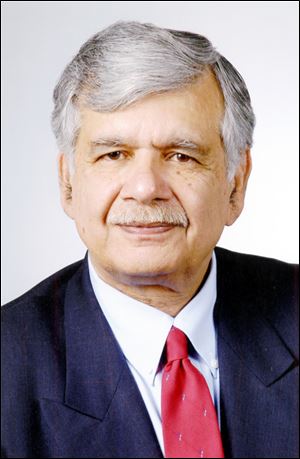
Of science and faith: Neither needs to be exclusive of the other
3/31/2014
Hussain
There were two intriguing and fascinating lectures this month at the University of Toledo. Held separately on two different days and venues, they touched upon science and religion.
The first lecture, “The Making of a Nobel Laureate,” was by Mario Capecchi, a 2007 recipient of the Nobel Prize in physiology.
In his hour-long lecture, he talked about his privileged early childhood in Verona, Italy, in the late 1930s, the dispatch of his socially and politically active mother to the Dachau concentration camp, and of fending for himself for four years on the streets of Italy.
His mother was released from Dachau following the allied forces’ victory in 1945. Mr. Capecchi said she found him after a year’s search on his ninth birthday in a hospital in Reggio Emmelia, in northern Italy.
Being on the streets and surviving as a homeless child, young Capecchi, by his own account, was a bully and a fighter. His mother, an American citizen, brought him to the United States, where the sharp edges of his personality were considerably softened by living in a Quaker community.
Once he started schooling, there was no looking back. A PhD in biophysics from Harvard University paved the way for cutting-edge genetic research that eventually led to the Nobel Prize.
His research involved discovering a method to control cells to change the genetic makeup of mice, and thus the mutation process in mice cells. The implications of this discovery are enormous and touch many areas of medicine, including cancer.
In 1980, his grant application to the National Institutes of Health was turned down with the terse remark that “his ambitions are not worthy of pursuit.” Four years later, the institute not only funded his research, but also apologized for the previous rejection by saying: “We are glad that you didn’t follow our advice.”
The hallmark of good science is that it can be repeated by others and achieve the same results. In the realm of religion, no such cause and effect experiments can be devised. Belief and disbelief are personal matters. Conclusions — both positive and negative — are reached by self-study or persuasion by others.
Which brings me to the second lecture. Alvin Plantinga’s topic was “Science, Religion, and Naturalism: Where the Conflict Really Lies.” He is a professor of philosophy at the University of Notre Dame. His seminal work is philosophy of religion, epistemology, metaphysics, and Christian apologetics. In 1980, Time magazine had called him America’s leading orthodox Protestant philosopher of God.
He accepts Charles Darwin’s theory of evolution, but with a proviso. He believes evolution was preordained and that it was not a random, unplanned, and unintended process as advocated by nonbelieving scientists. He mentioned Richard Dawkins’ 1986 book The Blind Watchmaker, in which the evolutionary biologist argues that the only watchmaker in nature is the blind force of physics.
In his lecture, Mr. Plantinga made the case for theism — the belief that God or gods exist. While he refrained from proving God’s existence, he also allowed that intelligent design couldn’t be proven scientifically.
An abiding faith in Christianity underpins Mr. Plantinga’s work. When asked whether his belief in theism is driven by independent reasoning or on his faith, he said that his faith has much to do with it.
Whether it is a higher power figuratively bent over a workbench — the sighted watchmaker — drawing blueprints for all living things, or a process independent of any supervisor is beyond the scope of science to settle. To rely on science to settle a religious argument is tantamount to asking a scientist to explain the science of falling in love.
It is helpful to remember that there are two different altars. Nonbelieving scientists pray at the altar of Newtonian physics. Those who are religiously inclined pray at the altar of a deity of their choice.
Those who attended the two lectures in the hope of narrowing the gap between science and religion probably were disappointed. These are two disparate realms. We don’t have to choose between them. It is acceptable to be a person of faith and also a person of science and pray at both altars.
In the prologue of his timeless elegy “In Memoriam,” Alfred Lord Tennyson wrote:
“By faith, and faith alone, embrace
“Believing where we can not prove.”
Dr. S. Amjad Hussain is a retired Toledo surgeon whose column appears every other week in The Blade.
Contact him at: aghaji@bex.net